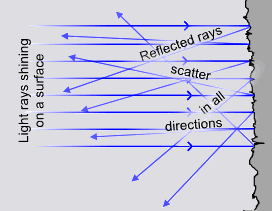It is true that there is generally a lot of confusion about the above concepts, especially in video projection. In this article, we will try to quickly decode the meanings, labeled at the outset that we are not, physicists, chemists, electrical engineers, structural or colour scientists.
Gain (gain): Is the capacity factor of reflection of light that has any material in nature. Each material has a specific profit. From a stone up to the trunk of a tree. The profit of materials depends on the following factors:
Α) Synthesis and properties of materials
B) How compact those are against their composition
C) color
Based on this calculated profit of materials automatically and their absorbance (gain and Absorption are the two opposite sides of the same coin). I won’t get into specialized cases e.g. contractions – expansion due to temperature can alter the profit or the angle of reflection, because, as we said at the outset, the purpose of the article is another and that we do not have such expertise, in order to analyze in depth all possible factors.
Let’s go to the video projection and screens.
Often-dense hear the term gain for the screens. This gain 1, 1.3, 2, 0.4 etc. Keep in mind the general definition given initially and go one step further:
What gain 1;
Gain (gain) is the percentage ratio of light which is reflected by our screen compared to two white reference such as barium sulfide (barium sulfide) or magnesium carbonate (chalk). These two materials are considered as reference reflectance of white light Lampertianoy in the sense that the reflected light is diffused evenly and with the same intensity in all directions. A display with 1 gain means that reflect the same proportion of light with a surface of chalk.
Gain 1, well, it means 2 things:
A) Reflection light rate equal to that of chalk,
B) Diffusing light to distribute evenly in all directions.
It is obvious, therefore, that whatever the screen does not meet simultaneously, and 2 those conditions, not a profit 1. Make it clear at this point how measurements are made taking as reference point the center of the screen. Practically, well, what happens …
Take a piece of chalk and a sprinkle of white light. Measure from the center point and receive a value (e.g. 10 FL). Travelling at various angles (10th – 20th – 30th etc.) and xanapairnoyme prices. Our prices will be again 10 FL.
If the screen does not have the same behavior, not a profit 1, but either more or less. For now we keep it:
As profit grows, so the viewing angle gets smaller in relation to the brightness that we received on the vertical axis. So, a screen with gain 1.3 (which gives 30% more light on the vertical axis from the chalk, e.g. 13 FL) will give us less light angled 10th – 20th, and so on, creating the so-called “hot spotting (light distribution with unequal angle) causing the brightness to vary.
Question:
And what do I care? I sit in the perfect location, just opposite the screen and in the Centre of … Therefore, I have no hot spot and I can go on screens with greater profit. Correctly?
Wrong!!
Because the frame is not a point, but has specific dimensions. Therefore, as most large, so grows and the viewing angle resulting in the hot spot to becomes more and more evident. Think. … the scenes take place not only at the center of the scene, but, across its surface, which necessarily see an angle. Your Centre will be brighter and around the brightness will have dropped considerably. So much that it evokes something:
The example is indicative to describe the phenomenon of hot-spotting. There are no axioms here, e.g.
You seem so 80ara and screen or will see it so only at 120 inches;
No comment… for now we keep it as gain increases and our frame, the more obvious it will becomes the phenomenon and in greater volume.
How involved the colors, materials and their composition, will analyze in our next article.
Ygiainete!!
To thank the wbassett for providing the exceptional and highly interesting information!! You can read in English the article from this link:
http://www.hometheatershack.com/forums/general-screen-discussion/5977-gain-other-confusing-topics.html




